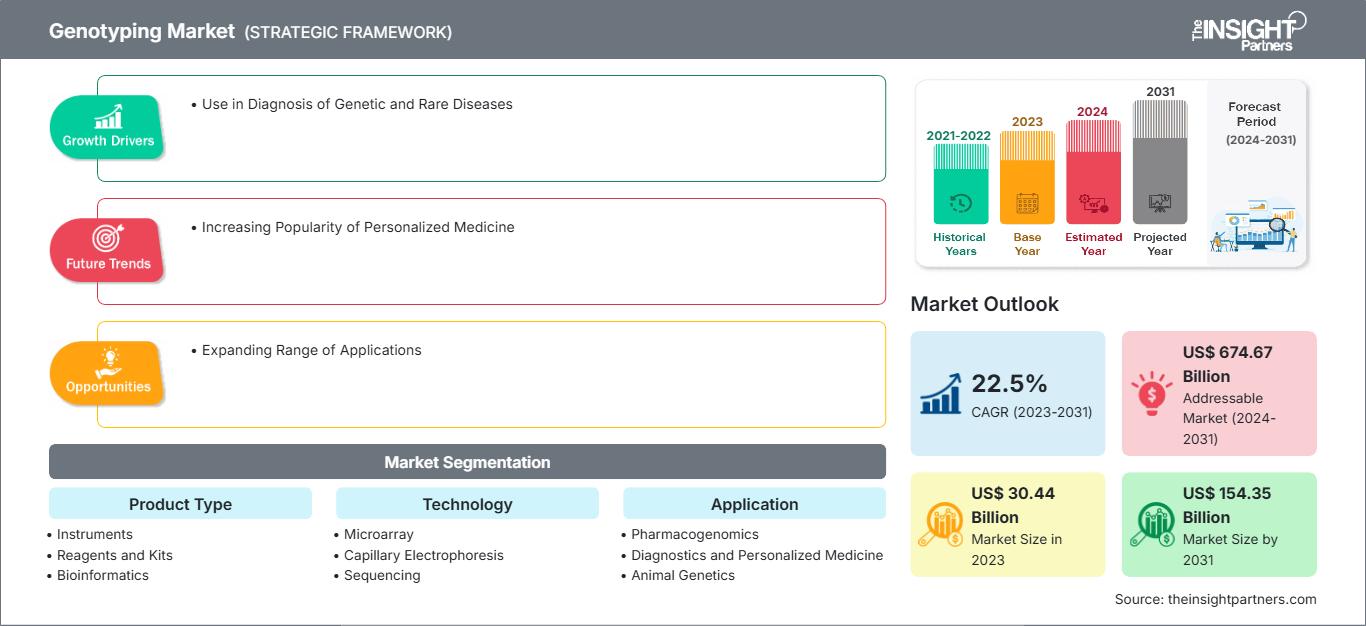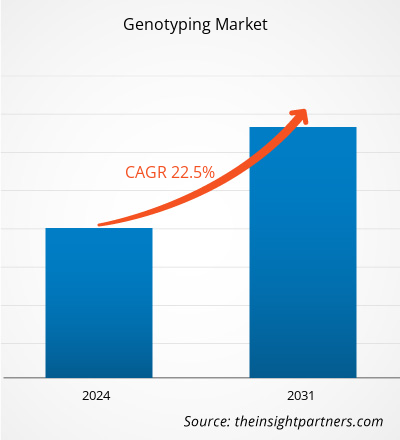Der Markt für Genotypisierung soll von 30,44 Milliarden US-Dollar im Jahr 2023 auf 154,35 Milliarden US-Dollar im Jahr 2031 anwachsen. Für den Markt wird zwischen 2023 und 2031 eine durchschnittliche jährliche Wachstumsrate (CAGR) von 22,5 % erwartet. Dank zunehmender Sensibilisierungsbemühungen und -kampagnen werden die vielfältigen Anwendungsmöglichkeiten der Genotypisierung, darunter personalisierte Medizin, Landwirtschaft und Tierzucht, auch weiterhin die wichtigsten Markttrends bleiben.
Marktanalyse für Genotypisierung
Die Entwicklung von Hochdurchsatz-Genotypisierungstechnologien wie Next-Generation-Sequencing und Microarray-Analyse hat dem Genotypisierungsmarkt zugutegekommen. Der daraus resultierende zunehmende Einsatz der Genotypisierung in Landwirtschaft und Tierzucht zur Verbesserung der Ernteerträge, Entwicklung krankheitsresistenter Nutzpflanzen und Steigerung der Viehproduktion ist einer der Haupttreiber für das Wachstum des Genotypisierungsmarktes. Die laufenden F&E-Aktivitäten in Genomik, Genetik und verwandten Bereichen, die zur Entdeckung neuer genetischer Marker und Assoziationen mit Krankheiten führen, tragen ebenfalls zum Marktfortschritt bei.
Marktüberblick Genotypisierung
In Indien sind genetische Störungen relativ häufig, was auf die enorme Bevölkerungszahl, die hohe Geburtenrate und die Bevorzugung von Blutsverwandten in manchen Gemeinschaften zurückzuführen ist. Es werden Forschungs- und Entwicklungsarbeiten (F&E) in den Bereichen Humangenetik, Genomanalyse und Präzisionsmedizin durchgeführt, um die Belastung durch solche Krankheiten durch das Verständnis des Mutationsspektrums von Krankheiten potenziell zu reduzieren. Diese F&E-Programme konzentrieren sich auf die Implementierung von pränatalen und Neugeborenen-Screening-Programmen, die Entwicklung kostengünstiger Diagnosemethoden und erschwinglicher Therapien für genetische Krankheiten sowie die Schaffung personalisierter Behandlungspläne.
Genetische Störungen wie Krebs sind in Indien weit verbreitet. Laut WHO litten im Jahr 2022 in Indien etwa 1,41 Millionen Menschen an Krebs. Der Artikel mit dem Titel „Breast Cancer Survival in India Across 11 Geographic Areas Under the National Cancer Registry Programme“ (Überlebensrate von Brustkrebs in Indien in 11 geografischen Gebieten im Rahmen des Nationalen Krebsregisterprogramms) führt Brustkrebs als die häufigste Krebsart im Land auf, da er etwa 28,2 % aller Krebsfälle bei Frauen ausmacht; im Jahr 2022 wurden bei Frauen etwa 216.108 Brustkrebsfälle gemeldet.
Wichtige Programme und Initiativen in der Genomforschung in Indien werden nachstehend aufgeführt:
- DBT – Initiative für einzigartige Methoden zur Behandlung von Erbkrankheiten (UMMID)
- GenomeIndia
- Initiative zum menschlichen Mikrobiom ausgewählter endogamer Populationen Indiens
- Programm zu monogenen Erkrankungen
- National Genomics Core
Daher würde eine steigende Zahl von Programmen und Initiativen in der Genomforschung in den kommenden Jahren erhebliche Chancen für das Wachstum des Genotypisierungsmarktes in Indien bieten.
Passen Sie diesen Bericht Ihren Anforderungen an
Sie erhalten kostenlos Anpassungen an jedem Bericht, einschließlich Teilen dieses Berichts oder einer Analyse auf Länderebene, eines Excel-Datenpakets sowie tolle Angebote und Rabatte für Start-ups und Universitäten.
Genotypisierungsmarkt: Strategische Einblicke

- Holen Sie sich die wichtigsten Markttrends aus diesem Bericht.Dieses KOSTENLOSE Beispiel umfasst Datenanalysen, die von Markttrends bis hin zu Schätzungen und Prognosen reichen.
Sie erhalten kostenlos Anpassungen an jedem Bericht, einschließlich Teilen dieses Berichts oder einer Analyse auf Länderebene, eines Excel-Datenpakets sowie tolle Angebote und Rabatte für Start-ups und Universitäten.
Genotypisierungsmarkt: Strategische Einblicke

- Holen Sie sich die wichtigsten Markttrends aus diesem Bericht.Dieses KOSTENLOSE Beispiel umfasst Datenanalysen, die von Markttrends bis hin zu Schätzungen und Prognosen reichen.
Markttreiber und -chancen für die Genotypisierung
Einsatz bei der Diagnose genetischer und seltener Krankheiten begünstigt den Markt
Laut der Weltgesundheitsorganisation (WHO) werden bis 2050 voraussichtlich etwa 35 Millionen neue Krebsfälle auftreten, was einem Anstieg von 77 % gegenüber den entsprechenden 20 Millionen Fällen im Jahr 2022 entspricht. Im Jahr 2022 gab die Alzheimer's Association bekannt, dass die Zahl der Menschen mit Alzheimer in den USA rapide zunimmt. Die Krankheit betrifft mehr als 6 Millionen Amerikaner aller Altersgruppen. Schätzungen der Vereinigung zufolge litten im Jahr 2022 6,5 Millionen Amerikaner über 65 Jahre an Alzheimer, und 73 % dieser Bevölkerung waren 75 Jahre oder älter. Einer im Journal of Health Monitoring veröffentlichten Studie zufolge leiden weltweit bis zu 300 Millionen Menschen an seltenen Krankheiten. Obwohl einzelne Krankheiten selten sind, stellen sie zusammengenommen das globale Gesundheitssystem vor erhebliche Herausforderungen.
Da Krebs, Alzheimer und seltene Krankheiten klinisch schwer zu identifizieren sind, bildet die Genotypisierung das Rückgrat der diagnostischen Tests in der Bevölkerung. Durch Genotypisierung erhaltene DNA-Sequenzen können mit Proben- oder Referenzsequenzen verglichen werden, um Variationen festzustellen. Genotypisierung wird auch verwendet, um Einzelnukleotid-Polymorphismen (SNPs) zu erkennen, bei denen es sich um geringfügige Abweichungen im genetischen Komplement innerhalb der Bevölkerung handelt. Das menschliche Genom enthält fast 660 Millionen SNPs, was sie zur am weitesten verbreiteten genetischen Variation macht. Darüber hinaus können genomweite Assoziationsstudien (GWAS) durch den Vergleich von Polymorphismen in gesunden und kranken Populationen Verbindungen zwischen häufigen Krankheiten und SNPs aufdecken. GWAS können die molekularen Mechanismen zugrunde liegender Krankheitszustände entschlüsseln, indem sie wahrscheinliche Ursachen finden. SNPs kommen sogar in einzelligen Organismen wie Bakterien vor. Mithilfe der SNP-Genotypisierung können mikrobielle Isolate unterschieden werden und sie könnte sogar zur Identifizierung antibiotikaresistenter Stämme eingesetzt werden. Die SNP-basierte Stammerkennung hat einen signifikanten Einfluss auf jede pharmazeutische und klinische Analyse und wird auch in der Epidemiologie von Infektionskrankheiten eingesetzt.
Der Einsatz von Genotypisierungstechniken in der Diagnose genetischer und seltener Krankheiten stärkt daher den Genotypisierungsmarkt.
Wachsendes Anwendungsspektrum bietet Marktchancen
Die Genotypisierung bietet potenzielle Anwendungen in der diagnostischen Forschung, der Pharmakogenomik und der Agrarbiotechnologie. Darüber hinaus eignet sich diese Technik für eine Vielzahl von Verfahren in der Pflanzenzucht, Forensik und Umweltprüfung. Pharmaunternehmen profitieren unter anderem von der Verfügbarkeit polygener Risikobewertungen, umfangreicher genetischer Datenbanken mit Verknüpfungen zu Patientengesundheitsinformationen und Sequenzierungsdaten von Teilnehmern klinischer Studien. Die Industry Pharmacogenomics Working Group (I-PWG), ein Zusammenschluss pharmazeutischer Unternehmen, ist aktiv in der pharmakogenomischen Forschung tätig. Die I-PWG besteht aus 26 Mitgliedsunternehmen, die jährlich zahlreiche klinische Studien durchführen und im Rahmen des Protokolls DNA-Proben von Studienteilnehmern sammeln. Mit ihrem Fokus auf klinische Pharmakogenomik will die I-PWG in den kommenden Jahren neue Geschäftsmöglichkeiten für Pharmaunternehmen schaffen. Neben ihrer häufigsten Anwendung in der onkologischen Forschung wird die klinische Pharmakogenomik auch für PGx-Studien in nicht-onkologischen Therapiebereichen wie seltenen Krankheiten, Immunologie und Kardiologie eingesetzt. Eine umfassendere Studie mit NGS von Proben klinischer Studien ermöglicht eine detaillierte genomische Auswertung der Studienteilnehmer und deckt sowohl häufige als auch seltene genetische Variationen auf. PGx umfasst die Untersuchung polymorpher Unterschiede bei der Bestimmung von Arzneimittel-/Xenobiotika-Effekten auf Genomebene, der Arzneimittelreaktion und Krankheitsanfälligkeit sowie von Genotyp-Phänotyp-Beziehungen. Daher wird die stärkere Verbreitung der Genotypisierung in verschiedenen Forschungsbereichen letztendlich zu einem Anstieg der Nachfrage nach diesen Techniken führen und in den kommenden Jahren erhebliche Marktchancen schaffen.
Segmentierungsanalyse des Genotypisierungsmarktberichts
Schlüsselsegmente, die zur Ableitung der Genotypisierungsmarktanalyse beigetragen haben, sind Produkttyp, Technologie, Anwendung und Endbenutzer.
- Basierend auf dem Produkttyp ist der Genotypisierungsmarkt in Instrumente, Reagenzien und Kits, Bioinformatik und Genotypisierungsdienste unterteilt. Das Segment Reagenzien und Kits hatte 2023 den größten Marktanteil.
- Basierend auf der Technologie ist der Genotypisierungsmarkt in Microarrays, Kapillarelektrophorese, Sequenzierung, matrixunterstützte Laserdesorption/Ionisation-Time-of-Flight (MALDI-ToF)-Massenspektrometrie, Polymerase-Kettenreaktion (PCR) und andere unterteilt. Das PCR-Segment hatte 2023 den größten Marktanteil.
- Nach Anwendung ist der Genotypisierungsmarkt in Pharmakogenomik, Diagnostik und personalisierte Medizin, Tiergenetik, Agrarbiotechnologie und andere unterteilt. Das Segment Diagnostik und personalisierte Medizin hatte 2023 den größten Marktanteil.
- Basierend auf dem Endverbraucher ist der Genotypisierungsmarkt in Pharma- und Biopharmaunternehmen, Diagnose- und Forschungslabore, akademische Institute und andere unterteilt. Das Segment Pharma- und Biopharmaunternehmen hatte 2023 den größten Marktanteil.
Genotypisierungs-Marktanteilsanalyse nach Geografie
Der geografische Umfang des Genotypisierungsmarktberichts ist hauptsächlich in fünf Regionen unterteilt: Nordamerika, Asien-Pazifik, Europa sowie Naher Osten und Afrika. Nordamerika dominierte den Markt im Jahr 2023. Die zunehmende Verbreitung technologisch fortschrittlicher Produkte und Lösungen sowie die steigenden Forschungs- und Entwicklungsaktivitäten begünstigen den Genotypisierungsmarkt in dieser Region. Darüber hinaus treiben staatliche Programme wie das „All of Us Research Program“, Initiativen verschiedener Genomik-Communitys und die zunehmende Bekanntheit von Genotypisierungsdienstleistungen die Marktexpansion in Nordamerika voran. Der asiatisch-pazifische Raum wird im Prognosezeitraum voraussichtlich die höchste durchschnittliche jährliche Wachstumsrate verzeichnen.
GenotypisierungRegionale Einblicke in den Genotypisierungsmarkt
Die Analysten von The Insight Partners haben die regionalen Trends und Faktoren, die den Genotypisierungsmarkt im Prognosezeitraum beeinflussen, ausführlich erläutert. In diesem Abschnitt werden auch die Genotypisierungsmarktsegmente und die geografische Lage in Nordamerika, Europa, dem asiatisch-pazifischen Raum, dem Nahen Osten und Afrika sowie Süd- und Mittelamerika erörtert.
Umfang des Genotypisierungsmarktberichts
| Berichtsattribut | Einzelheiten |
|---|---|
| Marktgröße in 2023 | US$ 30.44 Billion |
| Marktgröße nach 2031 | US$ 154.35 Billion |
| Globale CAGR (2023 - 2031) | 22.5% |
| Historische Daten | 2021-2022 |
| Prognosezeitraum | 2024-2031 |
| Abgedeckte Segmente |
By Produkttyp
|
| Abgedeckte Regionen und Länder | Nordamerika
|
| Marktführer und wichtige Unternehmensprofile |
|
Dichte der Marktteilnehmer bei der Genotypisierung: Verständnis ihrer Auswirkungen auf die Geschäftsdynamik
Der Genotypisierungsmarkt wächst rasant, angetrieben durch die steigende Endverbrauchernachfrage aufgrund von Faktoren wie sich entwickelnden Verbraucherpräferenzen, technologischem Fortschritt und einem stärkeren Bewusstsein für die Produktvorteile. Mit steigender Nachfrage erweitern Unternehmen ihr Angebot, entwickeln Innovationen, um den Verbraucherbedürfnissen gerecht zu werden, und nutzen neue Trends, was das Marktwachstum weiter ankurbelt.

- Holen Sie sich die Genotypisierungsmarkt Übersicht der wichtigsten Akteure
Neuigkeiten und aktuelle Entwicklungen zum Genotypisierungsmarkt
Der Genotypisierungsmarkt wird durch die Erhebung qualitativer und quantitativer Daten aus Primär- und Sekundärforschung bewertet, die wichtige Unternehmenspublikationen, Verbandsdaten und Datenbanken umfassen. Einige der Entwicklungen auf dem Markt sind unten aufgeführt:
- Standard BioTools Inc. hat die NGS-Bibliotheksvorbereitungsfunktion auf dem X9 High-Throughput Genomics System eingeführt. Mit dieser Markteinführung können Kunden nun erstmals Echtzeit-PCR und Next-Generation-Sequencing (NGS)-Bibliotheksvorbereitungsanwendungen auf einem einzigen Tischsystem durchführen, um die Entdeckung durch Screening zu unterstützen. (Quelle: Standard BioTools Inc., Unternehmenswebsite, Mai 2023)
- Bio-Rad Laboratories, Inc. hat die Thermocycler PTC Tempo 48/48 und PTC Tempo 384 auf den Markt gebracht, die PCR-Anwendungen in der Grundlagenforschung und translationalen Forschung, Prozessentwicklung und Qualitätskontrolle unterstützen. Die Thermocycler PTC Tempo 48/48 und PTC Tempo 384 sind die neuesten Ergänzungen des Bio-Rad-Portfolios konventioneller PCR-Thermocycler. (Quelle: Bio-Rad Laboratories, Inc., Unternehmenswebsite, September 2022)
Bericht zum Markt für Genotypisierung: Abdeckung und Ergebnisse
Der Bericht „Marktgröße und -prognose für Genotypisierung (2021–2031)“ bietet eine detaillierte Analyse des Marktes in den folgenden Bereichen:
- Marktgröße und -prognose für Genotypisierung auf globaler, regionaler und Länderebene für alle abgedeckten wichtigen Marktsegmente
- Markttrends und Marktdynamiken für Genotypisierung wie Treiber, Einschränkungen und wichtige Chancen
- Detaillierte PEST/Porters Five Forces- und SWOT-Analyse
- Marktanalyse für Genotypisierung mit wichtigen Markttrends, globalen und regionalen Rahmenbedingungen, wichtigen Akteuren, Vorschriften und aktuellen Marktentwicklungen
- Branchenlandschaft und Wettbewerbsanalyse mit Marktkonzentration, Heatmap-Analyse, prominenten Akteuren und aktuellen Entwicklungen für den Genotypisierungsmarkt
- Detaillierte Unternehmensprofile
- Historische Analyse (2 Jahre), Basisjahr, Prognose (7 Jahre) mit CAGR
- PEST- und SWOT-Analyse
- Marktgröße Wert/Volumen – Global, Regional, Land
- Branchen- und Wettbewerbslandschaft
- Excel-Datensatz
Aktuelle Berichte
Erfahrungsberichte
Grund zum Kauf
- Fundierte Entscheidungsfindung
- Marktdynamik verstehen
- Wettbewerbsanalyse
- Kundeneinblicke
- Marktprognosen
- Risikominimierung
- Strategische Planung
- Investitionsbegründung
- Identifizierung neuer Märkte
- Verbesserung von Marketingstrategien
- Steigerung der Betriebseffizienz
- Anpassung an regulatorische Trends




















 Kostenlose Probe anfordern für - Genotypisierungsmarkt
Kostenlose Probe anfordern für - Genotypisierungsmarkt